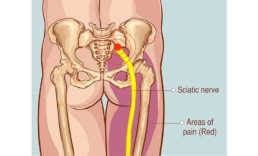Do you have pain radiating from your buttock to your calf? Perhaps you have discomfort running from groin to knee. Interestingly, both of these diverse problems may fall under the rubric of sciatica. So, what is sciatica and what causes sciatic nerve pain?
Sciatica Pain
Sciatica is not actually a medical diagnosis; it is a term that refers to any type of pain or weakness that is caused by irritation or injury to your sciatic nerve. Sciatica pain is most prevalent among people 30- to 50-years old.
The sciatic nerve is the longest nerve in the body. It comprises a number of nerves that exit your lower spine and meet up. The sciatic nerve runs from your lower back through the buttocks and hamstrings into your lower leg.
Sciatica Symptoms
Sciatica manifests itself in a number of ways, usually occurring only on one side of the lower body. Some of the most common sciatica symptoms are:
- Weakness or numbness in moving your foot or leg.
- Constant pain in the rear calf.
- A tingling or burning sensation in the leg.
- A “pins and needles” sensation in the leg.
- Shooting pain in the leg, making walking or standing up a challenge.
- Constant pain in the buttock that may radiate down the leg.
- Pain that decreases when walking or lying down, but ramps us while sitting or standing.
Your sciatica symptoms may intensify when you sneeze, cough or make other sudden movements or when you change positions.
Sciatica Causes
There are six injuries that are most often implicated in sciatica:
- Degenerative disc disease. Although our discs normally degenerate a bit with age, the weakened discs in some bodies irritate the nerve root, causing sciatica. Disc degeneration may also lead to bone spurs, which may press against a nerve and result in sciatica.
- Lumbar spinal stenosis. A narrowing of the spinal canal is relatively common in adults older than 60 and can cause pressure on the sciatic nerve through one or more factors, including bulging discs, overgrown soft tissue and enlarged facet joints. Spinal arthritis often accompanies spinal stenosis and can contribute to sciatica.
- Herniated lumbar disc. Herniated discs result when the fluid inside the disc leaks out beyond the core and irritates the nearby nerves, causing sciatica.
- Sacroiliac joint dysfunction. The sacroiliac joint is located at the base of the spine, and anytime it is irritated, the nerve that lies on top of it is also subject to irritation, causing leg pain similar to sciatic pain.
- Piriformis syndrome. The sciatic nerve runs under the piriformis muscle in the buttocks and may be subject to irritation or pinching by the muscle, causing sciatica-like pain.
- Isthmic spondylolisthesis. A small stress fracture in a vertebra can cause the vertebra to slip forward onto another, collapsing disc space and pinching the sciatic nerve.

Sciatic Nerve Pain Treatment
In order to treat sciatic nerve pain, your physician or physiotherapist must determine the underlying problem that is causing it. This can be a challenge, since two cases of sciatica can easily have the same symptoms but different causes. You may need an X-ray, a CT scan or an MRI to assess potential problems with your vertebrae.
Once this is accomplished, the focus can shift to relieving pain and pressure on the sciatic nerve and restoring the range of motion:
- Ice. Icing the affected area can help to reduce inflammation. Ice should be wrapped in a towel and applied for 20 minutes at a time.
- NSAIDs. Non-steroidal anti-inflammatory medications such as ibuprofen help to reduce the inflammation that may be a source of irritation for the sciatic nerve and surrounding tissues.
- Physiotherapy. Your physiotherapist will prescribe a course of stretching exercises to loosen any muscles that may be placing pressure on the sciatic nerve, as well as joints and tendons, plus strengthening exercises to help prevent a recurrence of the pain. Physiotherapy treatment for sciatic nerve pain may also include:
- Massage therapy to increase blood circulation and release of endorphins to fight pain
- Trigger point therapy
- Spinal mobilization
- Ultrasound and electrical stimulation
- Acupuncture. Long recognized for its effectiveness in relieving back pain.
How to Prevent Sciatic Nerve Pain
Unfortunately, sciatica has a tendency to re-occur, and bouts of sciatica can last as long as six weeks. You can play a part in preventing an episode of sciatica by playing an active role in your own physical health:
- Regular exercise. Make exercise part of your routine, focusing on activities or routines that strengthen the back and abdominal muscles. Swimming and Pilates are ideal; ask your physiotherapist about individual exercises.
- Posture. Keep an eye on your posture when sitting and standing. You may want to request an ergonomic assessment at work to ensure your chair, computer and desk are arranged to minimize inappropriate stresses.
- Sleep posture. Consider sleeping with a pillow between your knees or at your side so that your back is supported.
- Movement. If you have a desk job, make sure to get up and move every 20 to 30 minutes. Walk to the photocopier, the coffee pot or just up and down the hall.
- Lifting. Be sure that you lift heavy objects by using your leg and hip strength.
Sciatica is unpleasant, but the pain can be addressed. Treatment that occurs during the first 48 hours of onset will shorten the time you are indisposed.
